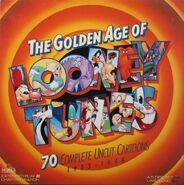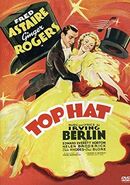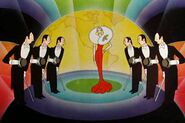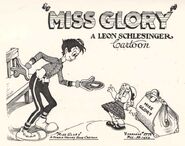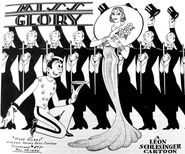Page Miss Glory is a 1936 Merrie Melodies short directed by Fred Avery.
Plot[]
A bellhop in a rural hotel waits for Miss Glory to arrive, but eventually falls asleep and dreams of attempting to meet her in a fancy art-deco hotel. When she finally arrives on a higher floor, the bellhop tries to operate the elevator but ends up falling off the roof of the hotel. His manager awakes him because the real Miss Glory has arrived, but instead of seeing a lady like he dreamed, he sees a child.
Availability[]
(1991) LaserDisc
The Golden Age of Looney Tunes Volume 1, Side 1: 1930s Musicals
The Golden Age of Looney Tunes Volume 1, Side 1: 1930s Musicals
(1992) VHS
The Golden Age of Looney Tunes Volume 1: 1930s Musicals
The Golden Age of Looney Tunes Volume 1: 1930s Musicals
(2008) DVD
Looney Tunes Golden Collection: Volume 6, Disc Four
Looney Tunes Golden Collection: Volume 6, Disc Four
(2008) DVD
Looney Tunes Spotlight Collection: Volume 6, Disc 2
Looney Tunes Spotlight Collection: Volume 6, Disc 2
(2012) Blu-ray
Looney Tunes Platinum Collection: Volume 2, Disc Two
Looney Tunes Platinum Collection: Volume 2, Disc Two
(2012) DVD
Looney Tunes Platinum Collection: Volume 2, Disc Two
Looney Tunes Platinum Collection: Volume 2, Disc Two
(2015) DVD
Looney Tunes Musical Masterpieces
Looney Tunes Musical Masterpieces
(2016) DVD
Music Triple Feature
Music Triple Feature
Censorship[]
- When this short aired on WNEW in the 1980s, the sequence where the Bellhop mistakes an old lady for Miss Glory and accidently causing her dress to rip due to him standing on her dress, causing the old lady to take some palm leaves and do a fan dance, was cut, most likely due to the suggestive nature of the scene.[3]
Notes[]
- This cartoon is notable as the first color cartoon Tex Avery directed, as well as the first Merrie Melodie he directed.
- This is the first "Merrie Melodie" not directed by Friz Freleng since "Rhythm in the Bow" two years prior (which was directed by Ben Hardaway); and the first color "Merrie Melodie" not directed by Freleng since the very first: the Cinecolor short "Honeymoon Hotel". (directed by Earl Duvall)
- This is the only cartoon where the entire crew is uncredited, with the only exception being Leadora Congdon who received onscreen credit as the layout and background artist, albeit credited as the "moderne art" designer and conceptionist. However, rural caricatures of some of the Warners crew, including Tex Avery, Chuck Jones, Bob Clampett and screenwriter Melvin Millar, appear outside the hotel at the end of the cartoon.
- It is also copyrighted as "Miss Glory".[4]
- The song is in the public domain, but the short is still under copyright.
- The film uses backgrounds and character designs largely inspired by that of Art Deco, a style of modernist visual arts, architecture and design that first appeared in France just before World War I.[5]
- The voices in this cartoon were provided by members of the Our Gang short film series, all of whom are uncredited.
- Most of this short takes place in the form of a dream sequence.
- Tex Avery was dismissive of this cartoon, likely because he was uncredited.[6]
- The elderly lady with the ripped dress and leaves would later reappear in the Looney Tunes Cartoons short "Daffuccino". In that appearance, she wore a teal dress instead of the yellow one she wore here.
Gallery[]
Caricatures of from left to right: Virgil Ross, Melvin Millar, Robert Cannon, Bob Clampett, Tex Avery, Sid Sutherland, and Chuck Jones
References[]
- ↑ Catalog of Copyright Entries
- ↑ https://looneytunes.fandom.com/wiki/File:Page_Miss_Glory_Cast.jpg
- ↑ http://mfoxweb-001-site22.mysitepanel.net/viewtopic.php?t=6925
- ↑ https://play.google.com/books/reader?id=AlVhAAAAIAAJ&printsec=frontcover&pg=GBS.PA216
- ↑ Schneider, Steve (1988). That's All, Folks! : The Art of Warner Bros. Animation. Henry Holt and Co. p. 46. ISBN 0-8050-0889-6
- ↑ http://texaveryatwb.blogspot.com/2013/05/page-miss-glory-reluctant-excursion.html

